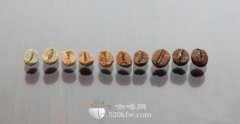Basic common sense system caffeine of fine coffee

There are a variety of small rules for roasting and extracting raw coffee beans. The big law formed by the combination of these small rules is systematic caffeine.
1. Coffee is divided into four types: according to its color.
A, white type, less water content.
B, cyan type
C, dark green
D, dark green type. It contains the most fruit.
two。 According to the color and shape changes of beans during baking, we can judge that beans belong to hard beans and soft beans.
A, when the raw beans become softer
B, on the first burst (light baking)
C, at the end of the first burst (medium baking-deep baking)
D, enter the second burst (city baking-deep city baking
3. Talk about from grinding to extraction:
A, fine grinding is strong and bitter. Extensive grinding tastes refreshing and bitter.
B, the more coffee powder, the stronger the bitterness (that is, the weaker the acidity), and the less the powder, the stronger the sour taste (the weaker the bitterness).
C, the higher the water temperature, the stronger the bitter taste (that is, the weaker the sour taste), and the lower the water temperature, the stronger the sour taste (the weaker the bitter taste).
D, the more coffee liquid extracted, the stronger the sour taste (that is, the weaker the bitter taste), and the less the coffee liquid extracted, the stronger the bitter taste (that is, the weaker the sour taste).
By making good use of these rules, you can know how bitter the coffee will be if the baking stops a few seconds later, and in order to find a way to balance the taste. By using "extensive grinding-less powder-low temperature extraction-rapid extraction-extraction more coffee liquid", the result is that the original outstanding bitterness is raised, and the taste becomes even. it can be seen how much impact extensive grinding can have on taste.
Important Notice :
前街咖啡 FrontStreet Coffee has moved to new addredd:
FrontStreet Coffee Address: 315,Donghua East Road,GuangZhou
Tel:020 38364473
- Prev

Coffee Roasting Every country in the world has its own preference for roasting
Each country in the world has its own preference for roasting, coffee beans will be due to different degrees of roasting, resulting in subtle changes in taste and aroma. Tokyo, slightly darker medium roasts are more popular, but slowly also tend to be darker roasts. In Kansai, deep baking has been popular since then. New York, as its name suggests, tends to prefer urban baking, but because of the city's inhabitants
- Next

Introduction to the roasting of high-quality coffee beans
One: coffee bean roasting purpose: 1: aroma 2: increase the complexity of coffee 3: to obtain color 4: to form the unique flavor of coffee and other functions. Second, the roasting method of coffee beans is divided into: fast roasting (the shortest time is 90 seconds, the traditional time is 12 minutes) slow roasting (12 minutes-40 minutes) three: coffee roasting has the following degrees: 1: shallow roasting
Related
- Beginners will see the "Coffee pull flower" guide!
- What is the difference between ice blog purified milk and ordinary milk coffee?
- Why is the Philippines the largest producer of crops in Liberia?
- For coffee extraction, should the fine powder be retained?
- How does extracted espresso fill pressed powder? How much strength does it take to press the powder?
- How to make jasmine cold extract coffee? Is the jasmine + latte good?
- Will this little toy really make the coffee taste better? How does Lily Drip affect coffee extraction?
- Will the action of slapping the filter cup also affect coffee extraction?
- What's the difference between powder-to-water ratio and powder-to-liquid ratio?
- What is the Ethiopian local species? What does it have to do with Heirloom native species?

